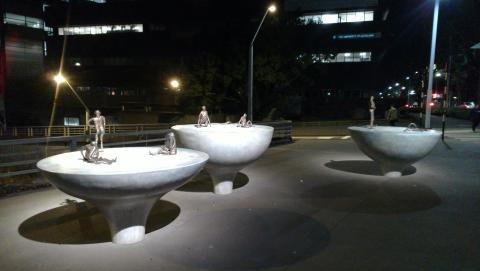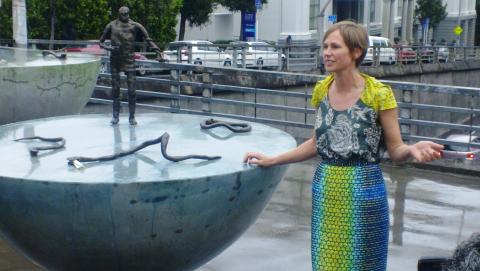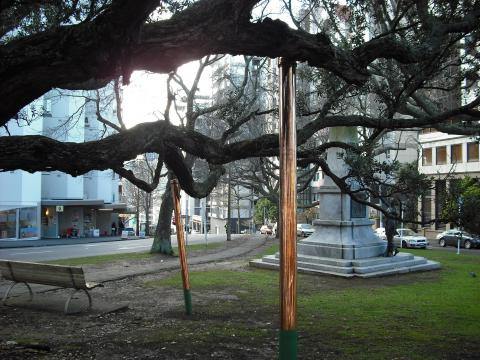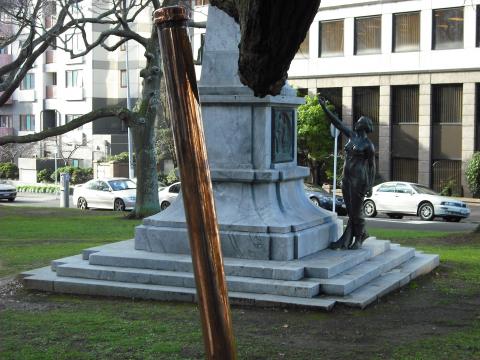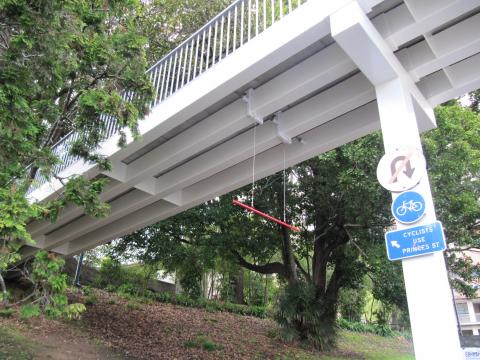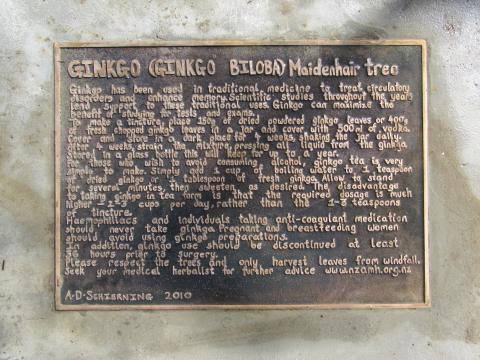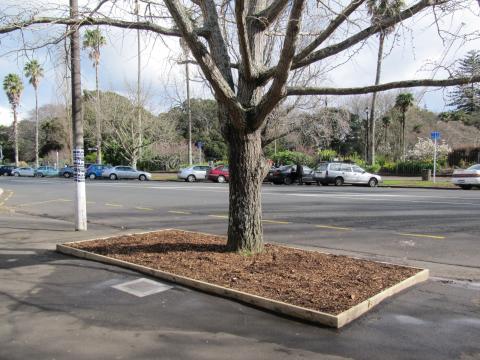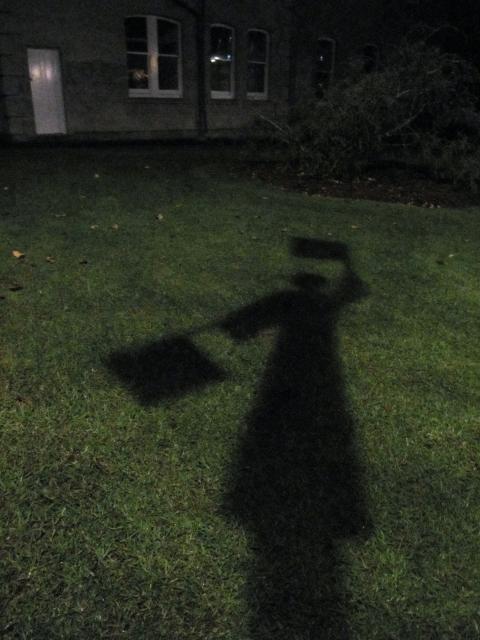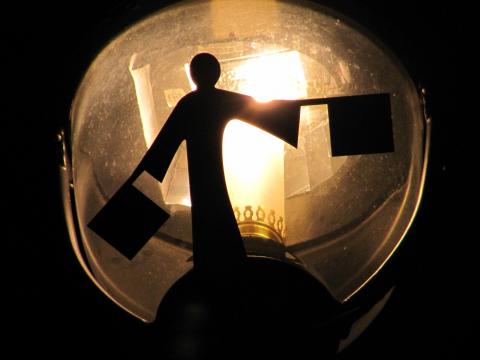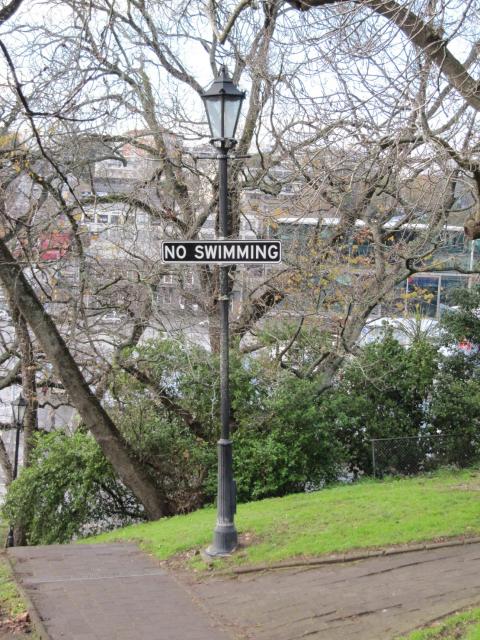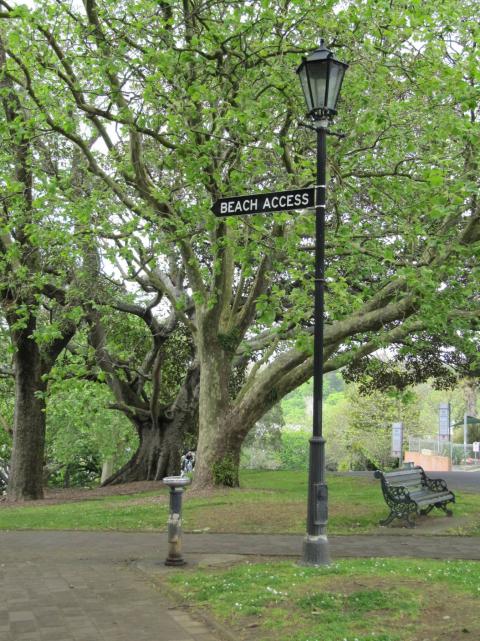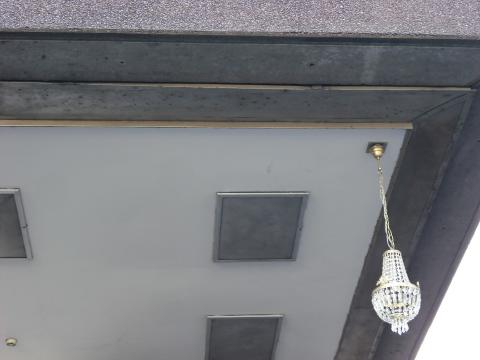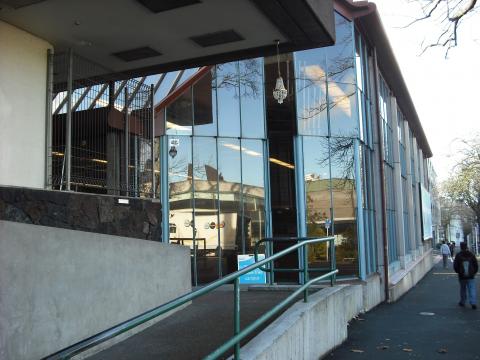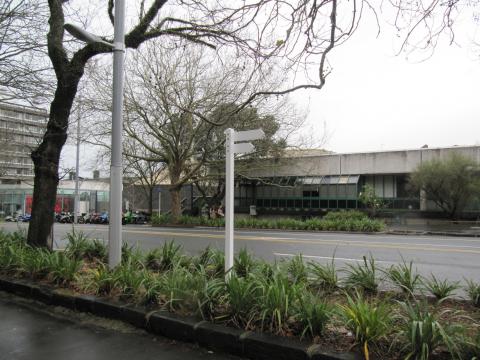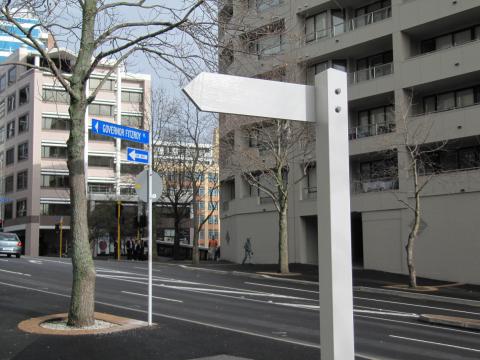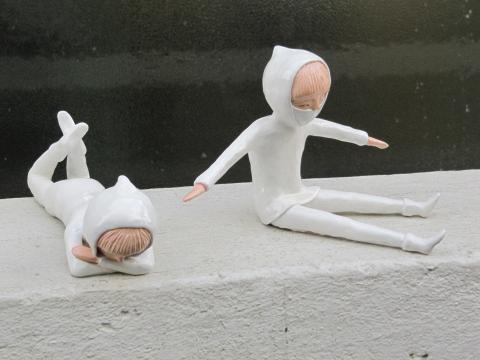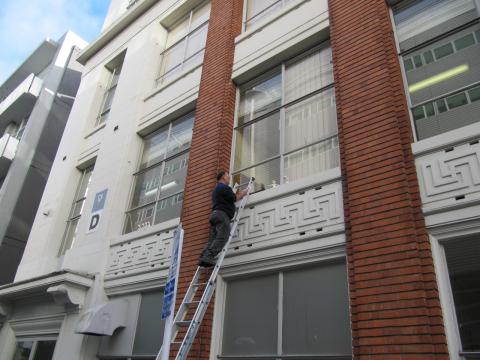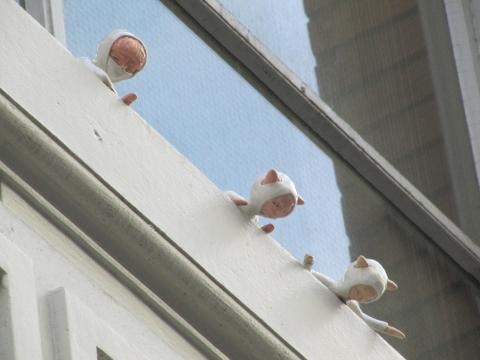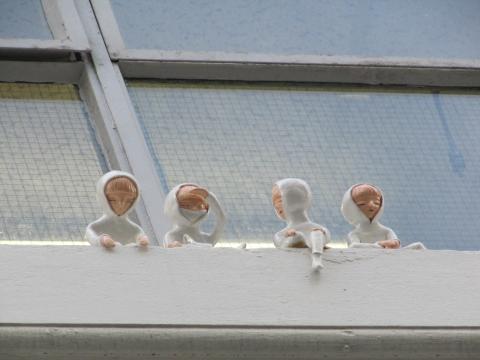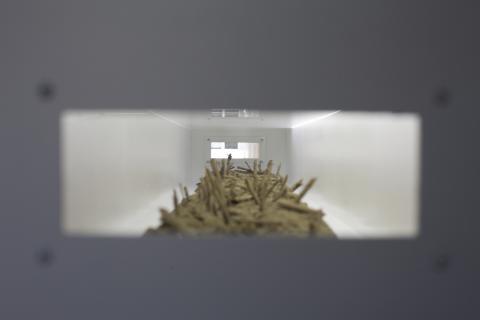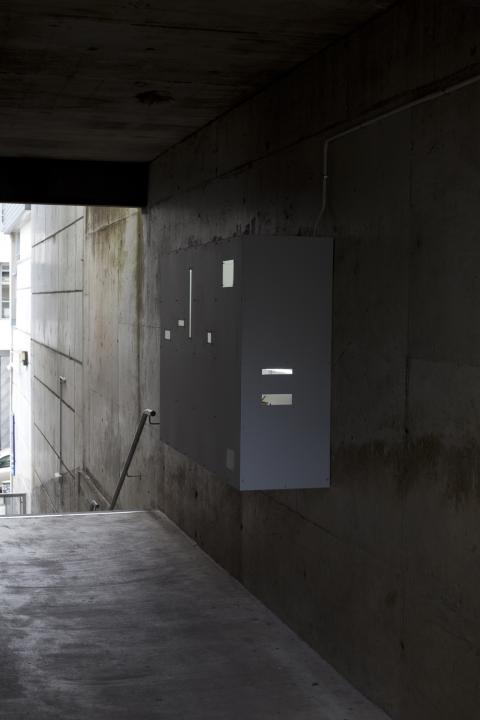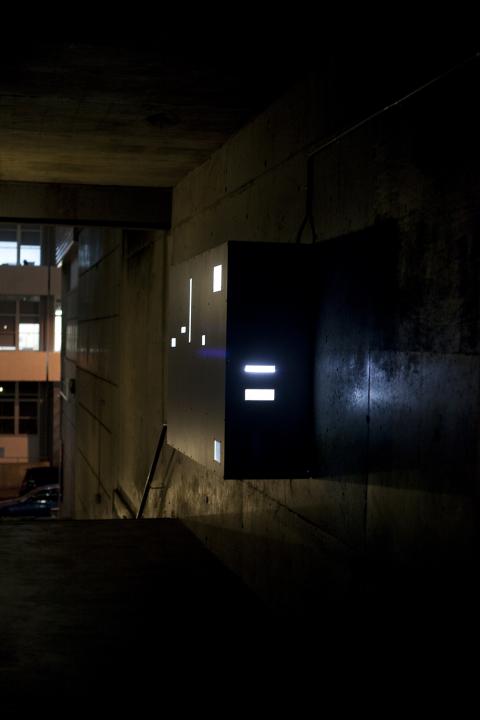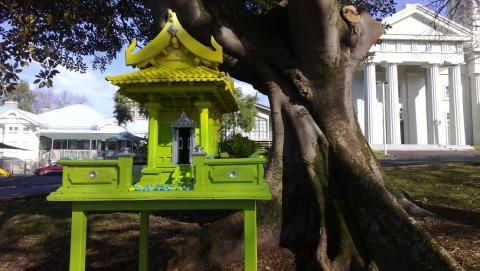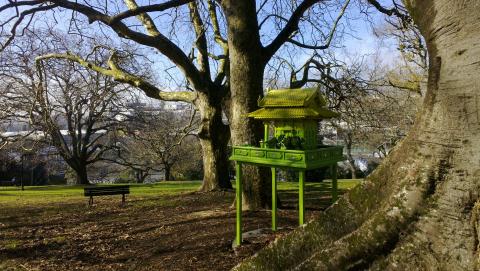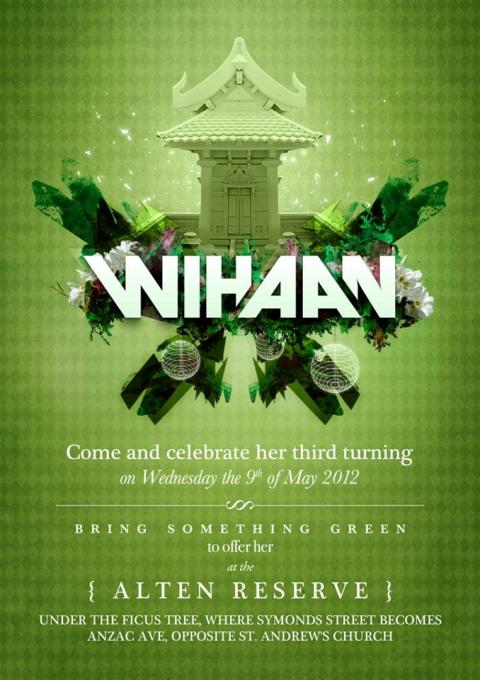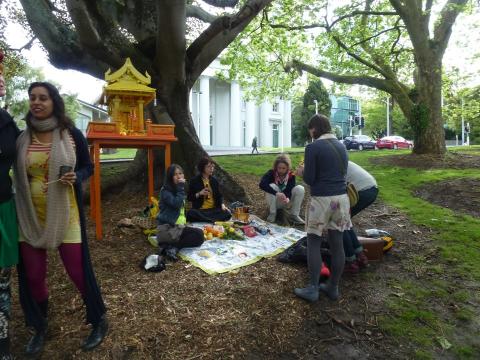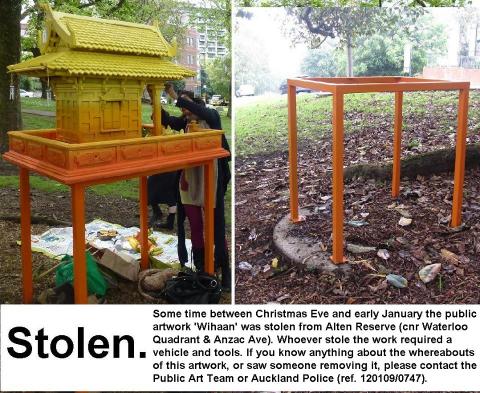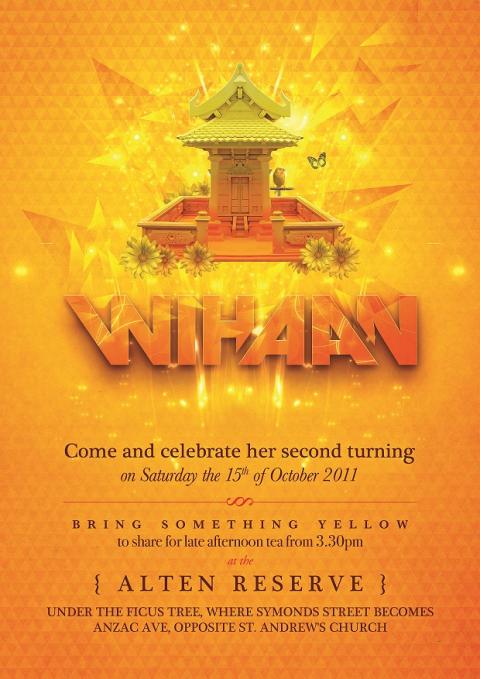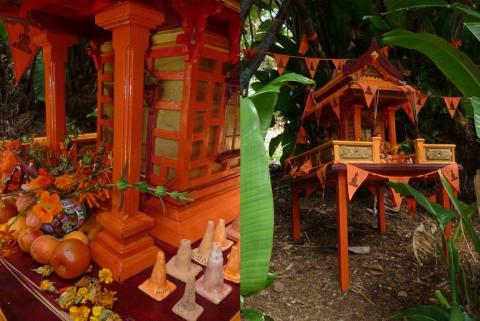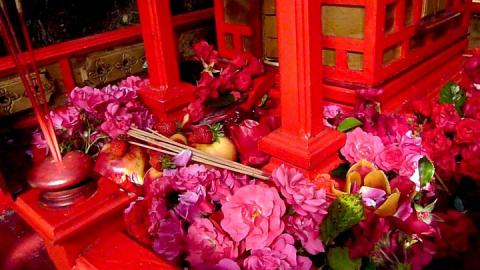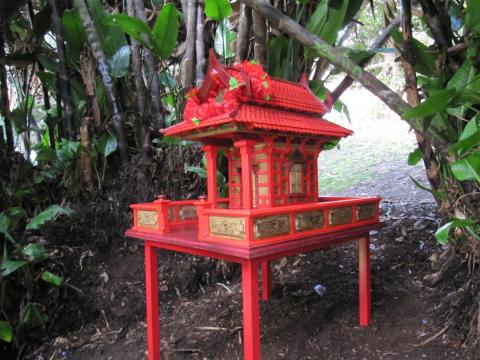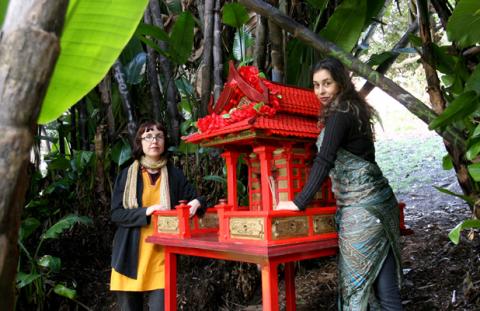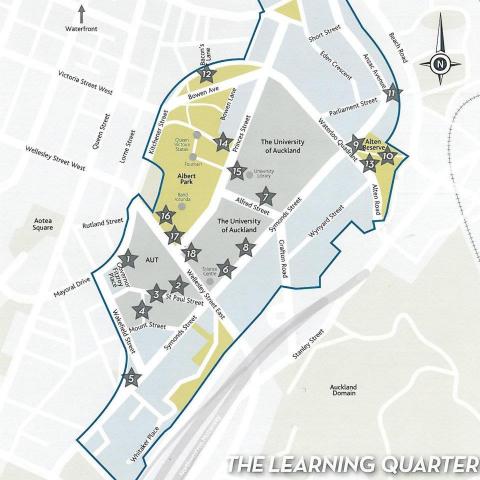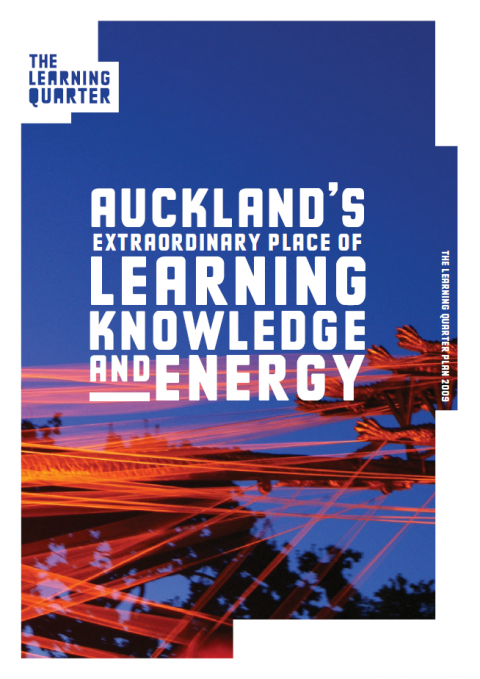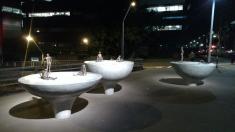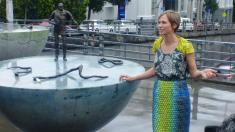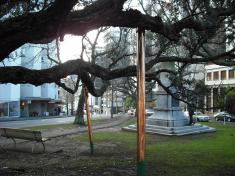Public art plan
Auckland's Learning Quarter
Francis Upritchard, "Loafers"
Francis Upritchard's new artwork "Loafers" (2012) in Auckland is the latest public art work to be developed from the city's Learning Quarter public art strategy, part of Auckland Council's award-winning 30-year Learning Quarter Plan.
London-based Francis Upritchard (Walters Prize 2006 and Venice Biennale 2009) was commissioned by Auckland Council in 2010 to develop an art work for the busy Symonds Street and Wellesley underpass intersection to help make the site better suited to the scale and speed of its pedestrian users. The site was identified in the Learning Quarter Public Art Strategy (written by Rob Garrett) as a key opportunity for public art to help fix the problems associated with major public transport uses and a rather bleak spatial environment that was increasingly a pedestrian hub for students attending the neighbourhood's two major universities as well as residents, workers and visitors. Commissioned to undertake her first ever public art work, by then Public Art Manager for Auckland Council Rob Garrett, the artist was asked to introduce a sculptural feature that would respond to the site and invite passersby to slow their pace and possibly linger.
The artist's concept engaged with various aspects of the site's proximity to the city's two major universities, the Auckland Art Gallery, a major historic church, a Maori marae (meeting place), and an area of the city with perhaps the largest concentration of heritage features:
My proposal is for figurative sculptures in bronze atop large, coloured concrete plinths.
The figures will be thinkers, layabouts and dreamers, lying heads propped, slouching or standing rubbing their heads, in the Learning Quarter.
The figures have historical out door art refernces, in particular to Henry Moore, but they are made in a very new way. The Loafers plinths reference important ceramic artist Lucie Rie. Rie pioneered domestic-ware in Britain, and her small works were developed at the same time as huge outdoor bronzes and in my mind, share a sort of 1950s aesthetic.
The characters of figures refer to the students of the Learning Quarter. Day dreaming, thinking and wondering will be manifest in the sculptures. I want them to have a louche, relaxed and confident feel. Characters happy to not have a day job, instead developing ideas, arguing and changing their minds.
Ron Bronson blogged the following in response to the completed sculptures:
The Wellesley Street over bridge has been a dead-space for years. While 1000s of people walk by daily, it has always seemed forlorn and ignored. Until now [....] I walk past Loafers almost every day. Its mix of standing and reclining figures with some attendant snakes is humorous and disquieting. Francis’s plinths feel like votive supports that honour the figures and present their miniature scale in a monumental way. They are a perfect mix for this location where you must pay attention to how you move, as the traffic’s presence is both hectic and threatening.
Micro Sites public art trail
Learning Quarter Micro Sites public art trail is a series of 12 small, temporary public art projects by 13 artists that are intriguing, subtle and surprising discoveries for people living, working and walking through Auckland’s Learning Quarter. The Learning Quarter encompasses Albert Park, The University of Auckland, AUT University and surrounding streets and neighbourhoods.
The idea for Micro Sites was the brain-child of Pontus Kyander (the inaugural Manager Public Art at Auckland City Council) and was further developed in the Learning Quarter Public Art Strategy. The Micro Sites project was conceived as an opportunity for emerging artists to create small-scale interventions that run against the grain or interfere with everyday perceptions and experiences of a place or neighbourhood. Micro Sites is a public art initiative of Auckland City Council developed in partnership with The University of Auckland and AUT University.
One of the trail's most delightful and subtle projects is "Stickup" by Taarati Taiaroa in the Wakefield Street pocket park. The artist isolated several unremarkable and perhaps overlooked features in the small triangular pocket park bounded on all sides by roadways.
Noticing that an old pohutukawa tree in the park had several of its branches supported by steel rods at one stage, but that since then, in each case the poles no longer touched or supported the tree, she decided to create a subtle intervention on each pole. Painstakingly removed, the dark green-painted poles were stripped, electroplated in copper, and returned to their original positions beneath the tree. Initially with a bright coppery patina, and gradually over time dulling and eventually becoming tarnished and perhaps coated in Verde Gris, the intervention is a gentle acknowledgement of an arborist's gesture of care.
Tessa Laird and Tiffany Singh, "Wihaan"
"Wihaan," a brightly coloured temple, is another of the 12 Micro Sites projects. Initially hidden among a grove of trees in Albert Park and now in a second site in Alten Reserve, but still within the Learning Quarter, the temple was designed by emerging artists Tessa Laird and Tiffany Singh.
In keeping with the commissioning brief to all the artists, to conceive an artwork that would have a lifespan of between 1 and 5 years, Laird and Singh determined that their small temple is set to be repainted with a new colour every six months. Starting out as red, the temple has since been repainted orange, yellow and green; and blue and violet will follow.
The artists also devised a community engagement aspect to the project. In addition to working with the Thai Buddhist Association in Kelston for assistance and Thai builder Thawee Khampantip, the temple artwork is on a rolling timetable where six Auckland artists will each have six months to care for it and paint it.
Intention and reality do not always coincide
Since Wihaan was first installed in Albert Park, vandalised; subsequently repaired and re-installed in Altern Reserve, briefly stolen and further vandalised, it has demostrated the contested nature of public space and acquired a contentious existence. Some aspects of this are usefully discussed in Daniel Michael Satele's review (and the asssociated discussion) in the online journal EyeContact (2 January 2014).
Excellence in Planning award
In 2011 the New Zealand Planning Institute awarded Auckland Council, University of Auckland, AUT University and Committee for Auckland The Nancy Northcroft Planning Practice Award, for the Learning Quarter Plan.
The Learning Quarter Plan and Public Art Strategy
Auckland's ‘Learning Quarter’ is a centre for education, research and commercialisation and is a key aspect to fuelling Auckland's future success. Covering 63 hectares, the Quarter has New Zealand’s largest concentration of students, researchers, teachers, innovators and creators, clustered in and around the university campuses. It is a vibrant place, characterised by significant heritage buildings, open spaces, rich cultural assets, a diverse range of events, and a growing residential community.
In 2009 the former Auckland City Council (amalgamated into the region-wide Auckland Council in 2010) developed a 30-year urban plan for the Learning Quarter. The Learning Quarter Plan was developed in partnership with the University of Auckland and AUT University, and through consultation with businesses and residents. The plan expresses the vision of the Learning Quarter partners and outlines how they will work together to guide and help drive the area's economic, social, cultural and physical development.
Rob Garrett was commissioned to develop a strategy for the integration of public art within the Learning Quarter as a part of the overall plan.
The Learning Quarter Plan identifies many actions that aim to improve the urban environment, strengthen the community and support economic growth. Incorporating public art was recognised as one way the quarter could express its distinctiveness and character.
The Learning Quarter Council’s public art strategy includes identifying and interpreting sites and opportunities with potential for public art activity; and identifying types of public art projects and approaches that are suitable for integration within council’s overall Learning Quarter plan. The strategy was guided by Auckland City Council’s 2008 public art policy goals and responsive to the special nature and character of the Learning Quarter as a whole and to the particularities of each site. Within the Learning Quarter Plan public art is expected to:
- Contribute to the sense of place;
- Enhance environments and activities and the legibility of the quarter as a whole;
- Express, reflect, re-interpret and re-invigorate the history, heritage, activities and achievements related to the quarter;
- Contribute to people’s sense of safety (including road safety);
- Encourage people to stay in places for longer;
- Be embedded within council’s public works schemes;
- Enable council to engage with the universities and Tangata Whenua;
- Enable artists and architects to collaborate to develop neglected spaces;
- Create environments that go beyond the regular experience of place;
- Contribute to improved connectivity within the quarter; and
- Include working to encourage public art projects in private development.
The Learning Quarter Public Art Strategy specifically:
- Investigates the feasibility and potential of previously identified sites;
- Identifies possible sites/areas for public art projects;
- Identifies the types of projects that could be developed, including small and easily implemented projects that require smaller budgets, as well as larger projects that may be considered for the long term, such as over the next 10-30 years;
- Provides narrative based on the concepts and issues outlines above;
- Indicates likely budgets for each of the projects;
- Provides an outline of relevant background information about the history and heritage of the Learning Quarter and outlines key activities/achievements by people connected to the area;
- Includes a summary list of reference material;
- Outlines an overall implementation plan for the public art projects;
- Makes recommendations about how stakeholders can continue engagement in the process of public art development in the Learning Quarter beyond the completion of this report;
- Makes recommendations around possible temporary projects linked to creative/cultural events such as the Lantern Festival, Living Room project, etc. that will enliven the CBD/Learning Quarter; and
- Identifies and suggests several priority projects.
The strategy for the integration of public art within the Learning Quarter sets out four curatorial themes, Openness, Discovery, Arrival, Connection; and notes the following points:
-
There are two planes (layers) to public art activity:
- The robust, structural plane which is about place-making, improvement and making improving people’s safety; and
- The small-scale, playful layer of activity which is about disrupting order and re-defining knowledge (sometimes these disruptions will be challenging and controversial; sometimes they will be whimsical and humorous – both should be anticipated and welcomed);
- Interpretation and re-interpretation of existing features, attributes, histories, etc:
- i.e. art does not work from a “zero base” and should capitalise on what is already there (that is working);
- Public art planning will recognise and value Auckland’s Maori and colonial heritage;
- Art should be a part of fixing what’s wrong;
- Public art can and should contribute to creating more liveable places, liveable streets;
- Public art can and should contribute to the Learning Quarter being a destination – not just for visitors, but highly attractive for residents, business, and students and staff of the Learning Quarter’s institutions;
- The Learning Quarter has untapped “creative city” potential and public art can help;
- Public art should only be developed in dialogue with residents and users;
- There should be an emphasis on creating liveable streets through attention to good building design and streetscapes over time,
- Art interventions may be non-permanent and dynamic, thus contributing the sense of liveliness and that things can change;
- Residential areas (there are 2 significant ones in the Learning Quarter) require sensitive and light-handed treatment – in these areas:
- Marking edges and gateways;
- Enhancing personal safety;
- Improving pedestrian access;
- Enhancing the knowledge culture;
- Creating residential shared spaces;
- Making places coherent and legible in terms of function;
- Making more liveable street fronts;
- Goal 1: A distinctive city centre that reflects its multicultural identity, its history and its importance within the South Pacific;
- Goal 2: A compact city centre containing high-quality, compact, walkable, and mixed-use environments that help to reduce the time that people need to travel;
- Goal 5: A beautiful city centre where the design of our buildings, and spaces (including ordinary, everyday spaces) contribute to creating beautiful places for people to enjoy; and
- Goal 6: A human city centre where our built environment is respectful of people and how we experience the city – giving people priority over cars;
- Making places culturally rich and stimulating;
- Public art will deliver to four of council’s six urban design goals for the city:
- Change is an important dynamic, creating challenge and freshness – a public art programme should include art that changes, from temporary projects, through to lighting design that is interactive, or responsive to weather patterns, or programmed to change with the seasons;
- Giving expression to fast space and slow space [Philip Singleton];
- Making the memory of the place visible, audible and legible;
- An excellent public art programme includes fresh, imaginative and systematic approaches to providing information and interpretation for audiences (including through art trails of one form or another);
- Public art should make people stop and look, talk, question, smile, debate;
- The Learning Quarter’s public art audience is primarily pedestrian and project briefs and the art works that result should be sensitive to the ways people use and enjoy public space;
- Lighting design (1): The strategy suggests a number of light projects and lighting design initiatives as suitable for the Learning Quarter development. However, we also note that there is a growing interest in lightlessness, and in reducing light pollution and “sky glow.” We can only anticipate that these interests will further grow in New Zealand and that council should plan for the wise and environmentally sensitive use of lighting design. While public space light is more prevalent than ever, it is more vexatious than ever. Light consumes energy, and therefore new lighting projects have to be prepared to mitigate concerns that they might be wasteful or polluting;
- Lighting design (2): Architectural lighting has become commonplace in cities. Landmark buildings such as churches and heritage buildings are routinely lit at night. Lighting created by artists and designers is used by local authorities in conjunction with public arts bodies to add value, drama and interest. New directions in public lighting have come from artists as well as from lighting designers, architects and engineers. The current concerns for public lighting appear to be a greater interactivity, or the presence of a wider conceptual framework. Lighting is becoming smarter, drawing from ideas that merge art and technology.
